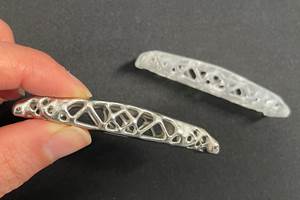AddUp Is Helping Bring Metal 3D Printing to Space
To make additive manufacturing in microgravity possible, the group has chosen to use a process that promotes forces induced by surface tension — wire-laser combination (W-DED).

AddUp is helping create a 3D printer that will produce the first metal parts in space in the International Space Station. Photo Credit: NASA/Roscosmos
AddUp is part of a “Metal3D” group project which is working to create a 3D printer to produce the first metal parts in space made via additive manufacturing (AM). The project is led by the European Space Agency (ESA), Airbus Defense and Space, and other industrial and academic partners such as Highftech Engineering and Cranfield University.
For the first time in history, a custom-made AM machine will be installed on board the International Space Station (ISS) within the Columbus module and be the first of its kind to be able to print in space.
This large-scale project involves several entities, including the ESA which commands the mission. Project management is provided by the Airbus Defense and Space teams in Toulouse. Their teams ensure the integration of the various components of the printer, power supply and conformity for the space environment. Cranfield University oversees the energy source and material delivery mechanism. In the case of metal 3D, this includes a laser and stainless-steel wire. The company Highftech is tasked with the manufacturing of the machine enclosure and integrating the machine’s fluid management. Finally, AddUp makes the internal structure and mechanisms of the machine, the PLC that controls it and the interface that enables communication with the ground.
“AddUp plays an important role in the realization of this mission, but its involvement in the project goes back to the preproject phase where the feasibility of the project had to be demonstrated,” says Alexandre Piaget, AddUp R&D engineer. “This first part, carried out on the premises in Salon de Provence, built the foundations of what the machine is today. In the final version of the machine, AddUp is in charge of the mobile axes, the structural parts and the software of the machine.”
On the mechanical side, AddUp’s team designed and manufactured the internal structure of the machine, including all moving parts. On the software side, they developed the machine’s automation program, which includes functions such as communication with the ground (sending of data, measurements, images and reports, and execution of commands received from Earth).
Metal3D is commissioned by the ESA as a technology demonstrator. The purpose is to characterize the mechanical properties of a material shaped in microgravity. To carry out this experiment, two batches of test specimens will be produced by two identical printers. While the first batch will be made in Toulouse in terrestrial gravity, the second will be built in space, within the Columbus module of the ISS in microgravity. To produce these two printing projects, two identical copies of a metal 3D printing machine capable of operating in both environments have been designed and produced.
The project challenge is production under microgravity. In the absence of gravity, most current AM processes are not usable. This is either because they are not compatible with the space environment (the use of fine powder is dangerous in the space station) or because their implementation is conflicting with microgravity (for example powder bed technologies).
To make manufacturing in microgravity possible, the partners have chosen to use a process that promotes forces induced by surface tension: this is the wire-laser combination (W-DED). A laser will be used as the energy source and a 316L stainless steel wire as the raw material. The laser and the wire feeding system are fixed in the machine frame and the printing table is made movable by three linear axes and one rotary axis. The machine is operated under nitrogen to limit the oxidation of the material and prevent the risk of combustion. As access to nitrogen is limited in the ISS, the machine’s atmosphere is filtered and cooled throughout the manufacturing process to limit nitrogen consumption and recycle as much as possible of the nitrogen already present in the machine.
Related Content
Aluminum Gets Its Own Additive Manufacturing Process
Alloy Enterprises’ selective diffusion bonding process is specifically designed for high throughput production of aluminum parts, enabling additive manufacturing to compete with casting.
Read MorePostprocessing Steps and Costs for Metal 3D Printing
When your metal part is done 3D printing, you just pull it out of the machine and start using it, right? Not exactly.
Read MorePossibilities From Electroplating 3D Printed Plastic Parts
Adding layers of nickel or copper to 3D printed polymer can impart desired properties such as electrical conductivity, EMI shielding, abrasion resistance and improved strength — approaching and even exceeding 3D printed metal, according to RePliForm.
Read MoreAM 101: What Is Hot Isostatic Pressing (HIP)? (Includes Video)
Hot isostatic pressing has long been used for metal castings, but is now being applied as a valuable method for closing porosity in metal 3D printed parts.
Read MoreRead Next
At General Atomics, Do Unmanned Aerial Systems Reveal the Future of Aircraft Manufacturing?
The maker of the Predator and SkyGuardian remote aircraft can implement additive manufacturing more rapidly and widely than the makers of other types of planes. The role of 3D printing in current and future UAS components hints at how far AM can go to save cost and time in aircraft production and design.
Read More4 Ways the Education and Training Challenge Is Different for Additive Manufacturing
The advance of additive manufacturing means we need more professionals educated in AM technology.
Read More3D Printing Brings Sustainability, Accessibility to Glass Manufacturing
Australian startup Maple Glass Printing has developed a process for extruding glass into artwork, lab implements and architectural elements. Along the way, the company has also found more efficient ways of recycling this material.
Read More




















